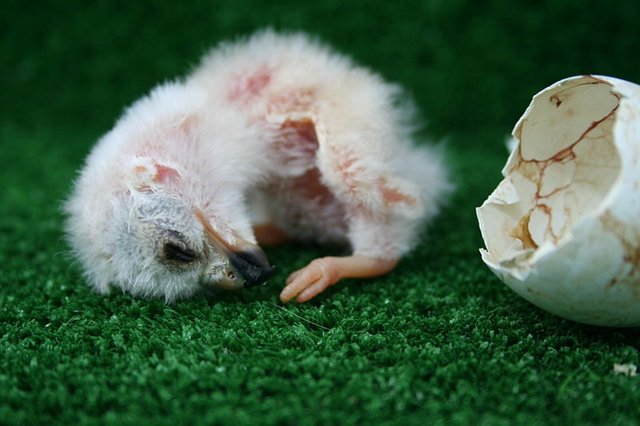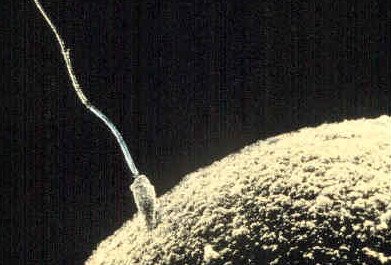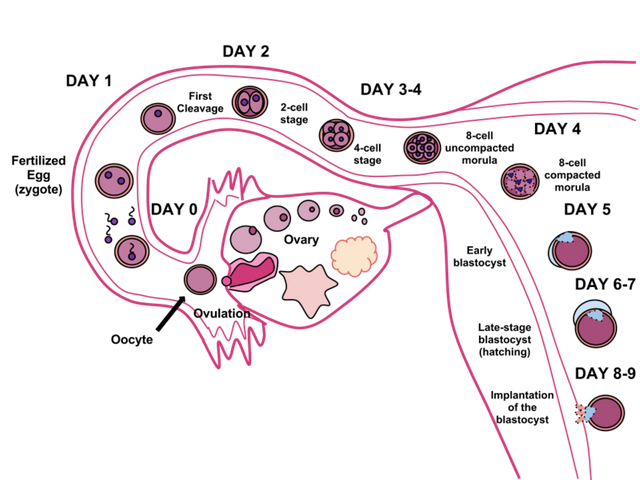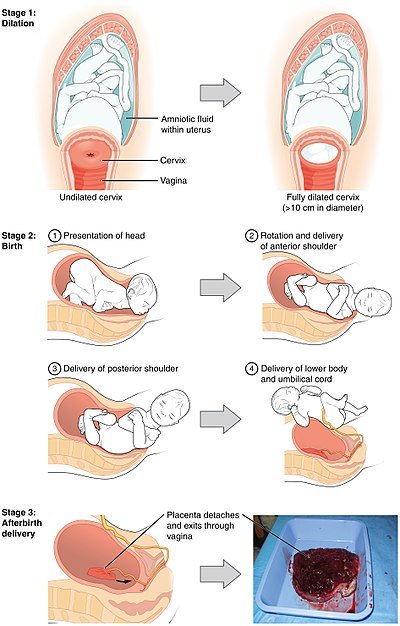Where do Babies come From? [INTRO TO EMBRYOLOGY]
I was fast awoken from an afternoon nap by my little sister, she looked confused and very inquisitive. "Where do babies come from?" she asked very loud my parent stared at me. I wonder why she didn't go ask mum, she should know how well to answer her. Confused from where to start from or to give her a come-back-in-ten-year-time tale. However, I told her I would tell her only if she can touch the jar of sugar in my room; I knew she wouldn't be able to for the next fifteen years, disappointed in me, she went to dad.
In actuality, many adult do not know where babies come from. Maybe they know but they have no idea about how the formation of his body come to be. In this post, I will be exposing us to the world of the beginning.

Babies are gifts from heaven, their body however is formed here on earth from the genes of their parents. This is why they look like their parent and as well share other traits and characteristics with them.
Image is sourced from pixabay.com under CC0 Licence.
Embryology is a branch of medical science that studies the intrauterine life of an offspring till it is born. It also includes the teratology which are the abnormalities and malformations of the the offspring. Life of an organism or baby begins at fertilization when a sperm cell fertilizes an ovum (oocyte) within the ampulla of an oviduct. This fertilization results in formation of a single cell known as an embryo. The embryo then journeys into the uterus or womb to develop further into a mature fetus. When the fetus grow to a stage it can withstand the external environment, it will be birthed through muscular contractions aided by abdominal muscle contraction.
Oviparity and Viviparity

Birds combines internal fertilazation with oviparous development of embryo
This file is licensed under the Creative Commons Attribution-Share Alike 3.0 Unported license. Author: Sarinahornay
Gestation is defined as the process or period from the conception of an organism to paturition or when it it born
Merriam-WebsterFertilization Beginning of life

A sperm has a tail which enables it move from the vagina to where the egg is so it can fertilize it.
This file is in the public domain, because It is free to use lawfully as stated on http://www.pdimages.com/web9.htm
Gametes however are capable of forming a new being, this is initiated ate fertilization. A typical somatic cell has 46 chromosomes (DiplodDictionary) which is not so in a germ cell. A germ cell has just 23 chromosomes (HaploidDictionary), at fertilization, the male and female gametes produce a zygote which now has 46 chromosomes. So an zygote is made up of somatic cells the resultant pack of cells is now a new organism.
At sexual intercourse, semen is being released into the female vagina. The female vagina is slightly acidic (pH between 3.5 and 4.8). This is essential to prevent growth of harmful micro-organism in the tract exposed to the external environment. Semen is made up of 1% of sperm, the remaining constituent of the fluid factors needed to neutralizes the acidity of the vagina to prevent mortality (death) of the sperm cells and as well aid its motility (movement). The sperm has to travel a long journey from the vagina to the uterine ducts (oviduct) to fertilize the eggs.
The average volume of semen released at ejaculation is between 2ml and 5ml. A 2.5ml semen contain approximately 250 million spermatocytes. Both only one will eventually fertilize the oocyte. A sperm can live up to 72 hours in a female reproductive tract before it dies. An oocyte dies within 24hrs of ovulation. For fertilization to occur, semen needs to have been present before the release of oocyte into the Fallopian tube.
Female Reproductive System and Menstrual Cycle
The female reproductive system is made up organs and tissue working together to bring forth a new organism into existence. It is made up of the primary sex organs which are a pair of ovaries and accessory organs. The accessory organs includes the fallopian tubes (oviduct, uterine tubes), uterus (womb), cervix, vagina, labias and clitoris. They are essential for sexual excitement as well as for reproduction. The ovaries produce oocytes, once in a month and as well produce hormones (progesterone and estrogen) responsible for female secondary characteristics.

All stages of the menstrual cycle are as a result of hormones: estrogen and progesterone being secreted in varying amount across each phase.
https://commons.wikimedia.org/wiki/File:Figure_28_02_07.jpg. Author: OpenStax College
- Outer Serous Layer
- Middle Muscular Layer
- Inner Endomerial/ Mucus Layer
The menstrual cycle is a rhythmic cycle of events that occur through out the reproductive period a woman (from onset of menstruation (menarche) to menopause). This is usuall between the ages of 12 or 15 and 45 or 50. The menstrual period lasts for twenty eight (28) days and repeats itself after the execution of one menstrual cycle. During this period, there are a series of changes that occur in the ovary as well as the other accessory reproductive organs. These changes can be divided into four groups:
- Ovarian changes of the ovary
- Uterine changes of the uterus
- Vaginal changes of the vagina
- Changes in cervix
Menstrual phase is a phase that occur when pregnancy does not occur. The endometrium is being shed off and expelled through the vagina as menses. It usually last 4 to 5 days. The day when bleeding starts is known as the first day of the menstrual cycle.
The proliferative stage begins from the 5th day to the 14th day of menstruation. Around this time, a follicle that will eventually release a mature oocyte from the ovary is also developing. The walls of the endometrium which was shed off during the last menses is being repaired ad vascularised (blood vessel is being supplied to the layer). This is essential in preparation for a possible pregnancy since that is the site of implantation of an embryo so as to absorb necessary substances for growth from the mother. On the 14th day, ovulation occur. If the egg is not fertilized within 24 hours, it dies which means the built up endometrium is not needed.
The secretory stage starts from the 15th day to 28th day of the menstrual cycle. The walls of the endometrium begins to deteriorate which finally leads to bleeding in the menstrual phase. And the cycle start all over again.
Initiation of life

Fertilisation occurs on the first day while implantation into the endometrial wall of the uterus occurs on the seventh day.
This file is licensed under the Creative Commons Attribution-Share Alike 3.0 Unported license. Author: Ttrue 12
Life begins at conception when the spermatocyte fertilizes an egg. The resultant of the fertilization is a single cell known as zygote. The sperm as a cell has a nucleus of 23 chromosomes and the oocyte also has 23 chromosomes. At fertilization, the two nucleus are present within the new shared cell membrane. The male nucleus is now referred to as the male pro-nucleus and the female nucleus as the female pro-nucleus. The new form cell now undergoes mitosis which incorporates the chromosomes of the two pro-nucleus. At the end of mitosis, the zygote now have two cells of 46 chromosomes each. Immediately, the two cells begin to undergo proliferation to create two cells each which leads to formation of four cells. The four cell go on to produce 8 cells, eight cell go on to thirty two until they can no longer be counted. The zygote soon develops into an embryo and then into a fetus.
The sex and major characteristic features of the child are determined at conception. The two pro-nucleus hold within them encoded materials known as genes. These are responsible for sex, height, facial contour, skin color as well as intelligence. These gene are found within the chromosomes. The last chromosome (chromosome 23) is responsible for the sex of a child. Chromosome 23 is also known as the sex chromosome while chromosome 1 to 22 are known as autosomes. There are two distinct chromosome 23 known, X or Y. The female egg has a constant chromosome x while a spermatocyte can carry the x or y chromosome. At fertilization, when the two pairs of sex chromosome from the father and the mother is gathered, the sex of the child is determined. A male child will eventually have a XY chromosome while a Female child will posses XX chromosome. Other features of a child are encoded more complexly in the genes found in chromosome of a child.
Now that fertilization has occurred, the zygote journeys to the uterus where it implants itself into the endometrium of the uterine wall. Implantation occurs on the seventh day after conception. The cells of the embryo are now numerous and performing distinct taxes. Some are function to bore into the endometrial wall and invade blood vessels, some are protecting the child from external factors while some are forming the body of the child proper. The group of cells forming the child proper are known as the embryoblast or inner cell mass. These cells are less involved in formation of placenta or umbilical cord.
The inner cells begin to proliferate and also specialize. Soon, a group of cells emerge from the inner cell mass known as the hypoblast and another set known as the epiblast. These two cells lied one on top of the other and form a disc known as the bilaminar germ disc. This occurs in the second week after fertilization. By the end of the third week, the cells now form a trilaminar germ disc consisting of a three distinct group of cells: Ectoderm, Mesoderm and Endoderm. The formation of the trilaminar germ disc is known as Gastrulation.These cells end up forming different organs and systems of the body. Study the below table which illustrates the derivatives of the trilaminar germ disc.
| Trilaminar Germ Dicsc | Derivatives |
|---|---|
| Ectoderm | Epiderm of skin, hairs, nails, sweat glands, sebaceous gland, brain and spinal cord |
| Mesoderm | Kidney, gonads, dermis of skin, blood cells, bones and muscles |
| Ectoderm | Epithelial lining of digestive tract and respiratory system. |
A child does not get his blood from the mother, it simply gets it by differentiating some mesodermal cells. This is why a child's blood can be unique from his mother's blood. The only support the mother gives the child is shelter, some antibodies, oxygen and nutritional benefits.
ParturitionGiving Birth, Labour

Sequence of events during parturition (Vaginal Birthing)
This file is licensed under the Creative Commons Attribution 4.0 International license. Author: OpenStax College
Vaginal delivery of fetus occurs in three stage: Shortening and opening of cervix, delivery of fetus and delivery of placenta. Shortening and opening of the cervix begins with a crampy abdominal pain usually accompanied with back pains which lasts for half a minute but occurs every ten to thirty minutes.
The second stage is the actual delivery of the child which lasts between thirty minutes to two hours. Then, the placenta is expelled within thirty minute of the actual birth. The placenta is an organ that enables the child absorb nutrient from the mother's blood. The placenta is connected to umbilical cord which contains blood vessels which entered into the child through the navel.
Abnormalities in fetus
Various abnormalities occur from the womb, some are simple while some could be life threatening. Common abnormalities are ectopia cordis, spina bifida, vitiligo, thoracopagus, down syndrome among others. Some of these abnormalities are as a result of defective gene inherited from parent, entrance of teratogens into the child or as a result of ingesting poisonous substances by the mother. In many cases, CT scan and other test on the amniotic fluid can reveal abnormalities in the growth of the fetus, if the condition is very severe, the couples are advised to abort the child.
Abortions Miscarriages symptoms and causes
The gestation period in humans is 9 months, however in many cases, the child does not live enough to be born at this speculated. It is expelled out of the mother due to diverse reasons, this is known as a miscarriage.Common reasons for miscarriages include:
- Chromosomal abnormality of child
- Infection
- Uterine Abnormality
- Diabetes
- Thyroid problem
- Bad lifestyle and drugs intake
Ectopic pregnancy is a common complication during pregnancy whereby a child grows else where than the expected place of growth. This could be the child growing in the thin fallopian tube, in the ovary, outside the womb, in the abdominal cavity or in the womb near the cervix and blocking its way. Ectopic pregnancy when detected are aborted instantaneously because they are life-threatening, there is no way a woman would survive ectopic pregnancy.
In my next post, we will move further and more scientific on the events of how a child develops right from fertilization till birth. Please, upvote, comment, re-steem and follow me @damzxyno.
Question for the day: With the advancement in technology by the day, do you think we are moving into an era of machinery taking the responsibility of nurturing a zygote till birth?
Do leave your answers in the comment box below,
thank you!!
You are Awesome!!!


Thanks for the good read for the brain!
I guess now the trick would be to explain this to the kids :)
Just the simple old answer will do "They come from heaven". No great teacher will be able to explain all this gibberish to a child except the child is a prodigy.
Give my question for the day a try, I'm interested in your say on the matter...
Thanks @csy
Thanks. I think it will be some time before I give it a try. I don't think my kid is old enough to ask that question yet, but if I remember this, I will definitely follow up!
@originalworks
@trufflepig
When you're not afraid to be yourself is when you're most incredible.Colors seem brighter when you're around.
@therealwolf 's created platform smartsteem scammed my post this morning (mothersday) that was supposed to be for an Abused Childrens Charity. Dude literally stole from abused children that don't have mothers ... on mothersday.
https://steemit.com/steemit/@prometheusrisen/beware-of-smartsteem-scam
Congratulations! Your post has been selected as a daily Steemit truffle! It is listed on rank 10 of all contributions awarded today. You can find the TOP DAILY TRUFFLE PICKS HERE.
I upvoted your contribution because to my mind your post is at least 27 SBD worth and should receive 121 votes. It's now up to the lovely Steemit community to make this come true.
I am
TrufflePig, an Artificial Intelligence Bot that helps minnows and content curators using Machine Learning. If you are curious how I select content, you can find an explanation here!Have a nice day and sincerely yours,

TrufflePigCongratulations! This post has been upvoted from the communal account, @minnowsupport, by Damzxyno from the Minnow Support Project. It's a witness project run by aggroed, ausbitbank, teamsteem, theprophet0, someguy123, neoxian, followbtcnews, and netuoso. The goal is to help Steemit grow by supporting Minnows. Please find us at the Peace, Abundance, and Liberty Network (PALnet) Discord Channel. It's a completely public and open space to all members of the Steemit community who voluntarily choose to be there.
If you would like to delegate to the Minnow Support Project you can do so by clicking on the following links: 50SP, 100SP, 250SP, 500SP, 1000SP, 5000SP.
Be sure to leave at least 50SP undelegated on your account.